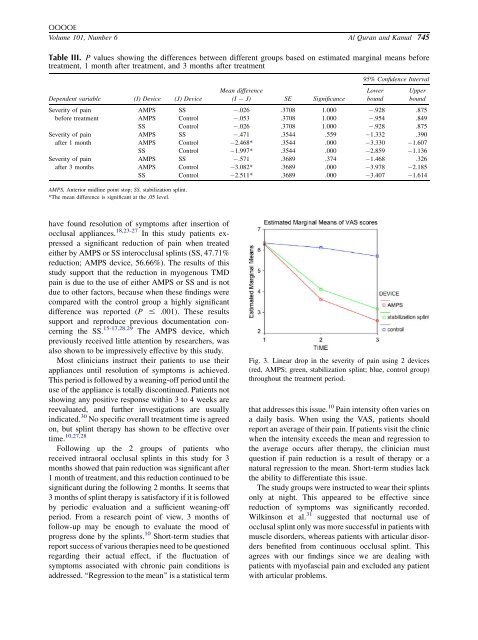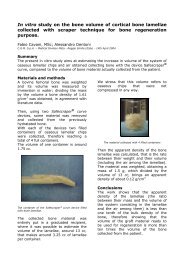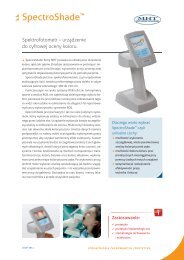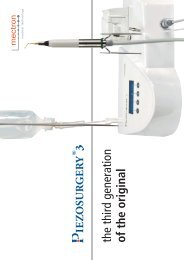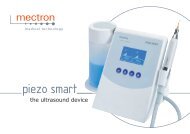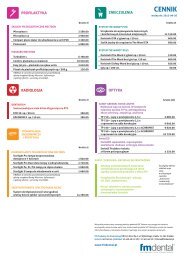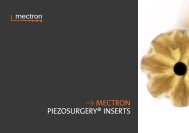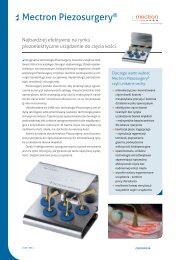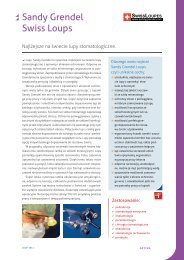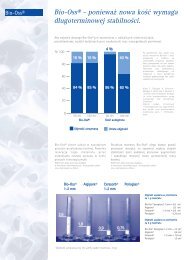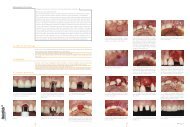Anterior midline point stop device (AMPS) in the treatment of ...
Anterior midline point stop device (AMPS) in the treatment of ...
Anterior midline point stop device (AMPS) in the treatment of ...
You also want an ePaper? Increase the reach of your titles
YUMPU automatically turns print PDFs into web optimized ePapers that Google loves.
OOOOE<br />
Volume 101, Number 6 Al Quran and Kamal 745<br />
Table III. P values show<strong>in</strong>g <strong>the</strong> differences between different groups based on estimated marg<strong>in</strong>al means before<br />
<strong>treatment</strong>, 1 month after <strong>treatment</strong>, and 3 months after <strong>treatment</strong><br />
Dependent variable (I) Device (J) Device<br />
Severity <strong>of</strong> pa<strong>in</strong><br />
before <strong>treatment</strong><br />
Severity <strong>of</strong> pa<strong>in</strong><br />
after 1 month<br />
Severity <strong>of</strong> pa<strong>in</strong><br />
after 3 months<br />
<strong>AMPS</strong>, <strong>Anterior</strong> <strong>midl<strong>in</strong>e</strong> <strong>po<strong>in</strong>t</strong> <strong>stop</strong>; SS, stabilization spl<strong>in</strong>t.<br />
*The mean difference is significant at <strong>the</strong> .05 level.<br />
have found resolution <strong>of</strong> symptoms after <strong>in</strong>sertion <strong>of</strong><br />
occlusal appliances. 18,23-27 In this study patients expressed<br />
a significant reduction <strong>of</strong> pa<strong>in</strong> when treated<br />
ei<strong>the</strong>r by <strong>AMPS</strong> or SS <strong>in</strong>terocclusal spl<strong>in</strong>ts (SS, 47.71%<br />
reduction; <strong>AMPS</strong> <strong>device</strong>, 56.66%). The results <strong>of</strong> this<br />
study support that <strong>the</strong> reduction <strong>in</strong> myogenous TMD<br />
pa<strong>in</strong> is due to <strong>the</strong> use <strong>of</strong> ei<strong>the</strong>r <strong>AMPS</strong> or SS and is not<br />
due to o<strong>the</strong>r factors, because when <strong>the</strong>se f<strong>in</strong>d<strong>in</strong>gs were<br />
compared with <strong>the</strong> control group a highly significant<br />
difference was reported (P # .001). These results<br />
support and reproduce previous documentation concern<strong>in</strong>g<br />
<strong>the</strong> SS. 15-17,28,29 The <strong>AMPS</strong> <strong>device</strong>, which<br />
previously received little attention by researchers, was<br />
also shown to be impressively effective by this study.<br />
Most cl<strong>in</strong>icians <strong>in</strong>struct <strong>the</strong>ir patients to use <strong>the</strong>ir<br />
appliances until resolution <strong>of</strong> symptoms is achieved.<br />
This period is followed by a wean<strong>in</strong>g-<strong>of</strong>f period until <strong>the</strong><br />
use <strong>of</strong> <strong>the</strong> appliance is totally discont<strong>in</strong>ued. Patients not<br />
show<strong>in</strong>g any positive response with<strong>in</strong> 3 to 4 weeks are<br />
reevaluated, and fur<strong>the</strong>r <strong>in</strong>vestigations are usually<br />
<strong>in</strong>dicated. 30 No specific overall <strong>treatment</strong> time is agreed<br />
on, but spl<strong>in</strong>t <strong>the</strong>rapy has shown to be effective over<br />
time. 10,27,28<br />
Follow<strong>in</strong>g up <strong>the</strong> 2 groups <strong>of</strong> patients who<br />
received <strong>in</strong>traoral occlusal spl<strong>in</strong>ts <strong>in</strong> this study for 3<br />
months showed that pa<strong>in</strong> reduction was significant after<br />
1 month <strong>of</strong> <strong>treatment</strong>, and this reduction cont<strong>in</strong>ued to be<br />
significant dur<strong>in</strong>g <strong>the</strong> follow<strong>in</strong>g 2 months. It seems that<br />
3 months <strong>of</strong> spl<strong>in</strong>t <strong>the</strong>rapy is satisfactory if it is followed<br />
by periodic evaluation and a sufficient wean<strong>in</strong>g-<strong>of</strong>f<br />
period. From a research <strong>po<strong>in</strong>t</strong> <strong>of</strong> view, 3 months <strong>of</strong><br />
follow-up may be enough to evaluate <strong>the</strong> mood <strong>of</strong><br />
progress done by <strong>the</strong> spl<strong>in</strong>ts. 10 Short-term studies that<br />
report success <strong>of</strong> various <strong>the</strong>rapies need to be questioned<br />
regard<strong>in</strong>g <strong>the</strong>ir actual effect, if <strong>the</strong> fluctuation <strong>of</strong><br />
symptoms associated with chronic pa<strong>in</strong> conditions is<br />
addressed. ‘‘Regression to <strong>the</strong> mean’’ is a statistical term<br />
Mean difference<br />
(I ÿ J) SE Significance<br />
95% Confidence Interval<br />
Lower<br />
bound<br />
Upper<br />
bound<br />
<strong>AMPS</strong> SS ÿ.026 .3708 1.000 ÿ.928 .875<br />
<strong>AMPS</strong> Control ÿ.053 .3708 1.000 ÿ.954 .849<br />
SS Control ÿ.026 .3708 1.000 ÿ.928 .875<br />
<strong>AMPS</strong> SS ÿ.471 .3544 .559 ÿ1.332 .390<br />
<strong>AMPS</strong> Control ÿ2.468* .3544 .000 ÿ3.330 ÿ1.607<br />
SS Control ÿ1.997* .3544 .000 ÿ2.859 ÿ1.136<br />
<strong>AMPS</strong> SS ÿ.571 .3689 .374 ÿ1.468 .326<br />
<strong>AMPS</strong> Control ÿ3.082* .3689 .000 ÿ3.978 ÿ2.185<br />
SS Control ÿ2.511* .3689 .000 ÿ3.407 ÿ1.614<br />
Fig. 3. L<strong>in</strong>ear drop <strong>in</strong> <strong>the</strong> severity <strong>of</strong> pa<strong>in</strong> us<strong>in</strong>g 2 <strong>device</strong>s<br />
(red, <strong>AMPS</strong>; green, stabilization spl<strong>in</strong>t; blue, control group)<br />
throughout <strong>the</strong> <strong>treatment</strong> period.<br />
that addresses this issue. 10 Pa<strong>in</strong> <strong>in</strong>tensity <strong>of</strong>ten varies on<br />
a daily basis. When us<strong>in</strong>g <strong>the</strong> VAS, patients should<br />
report an average <strong>of</strong> <strong>the</strong>ir pa<strong>in</strong>. If patients visit <strong>the</strong> cl<strong>in</strong>ic<br />
when <strong>the</strong> <strong>in</strong>tensity exceeds <strong>the</strong> mean and regression to<br />
<strong>the</strong> average occurs after <strong>the</strong>rapy, <strong>the</strong> cl<strong>in</strong>ician must<br />
question if pa<strong>in</strong> reduction is a result <strong>of</strong> <strong>the</strong>rapy or a<br />
natural regression to <strong>the</strong> mean. Short-term studies lack<br />
<strong>the</strong> ability to differentiate this issue.<br />
The study groups were <strong>in</strong>structed to wear <strong>the</strong>ir spl<strong>in</strong>ts<br />
only at night. This appeared to be effective s<strong>in</strong>ce<br />
reduction <strong>of</strong> symptoms was significantly recorded.<br />
Wilk<strong>in</strong>son et al. 31 suggested that nocturnal use <strong>of</strong><br />
occlusal spl<strong>in</strong>t only was more successful <strong>in</strong> patients with<br />
muscle disorders, whereas patients with articular disorders<br />
benefited from cont<strong>in</strong>uous occlusal spl<strong>in</strong>t. This<br />
agrees with our f<strong>in</strong>d<strong>in</strong>gs s<strong>in</strong>ce we are deal<strong>in</strong>g with<br />
patients with my<strong>of</strong>ascial pa<strong>in</strong> and excluded any patient<br />
with articular problems.


